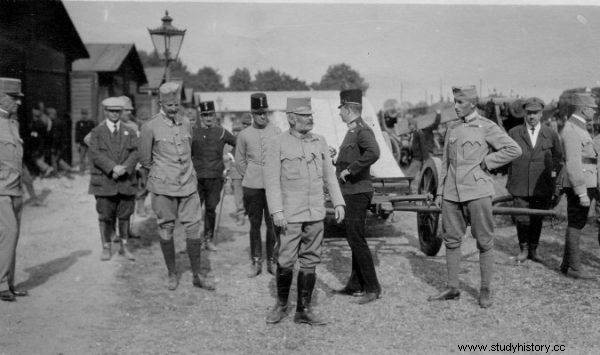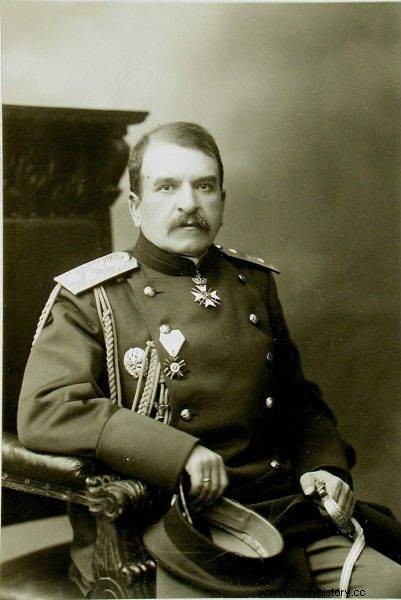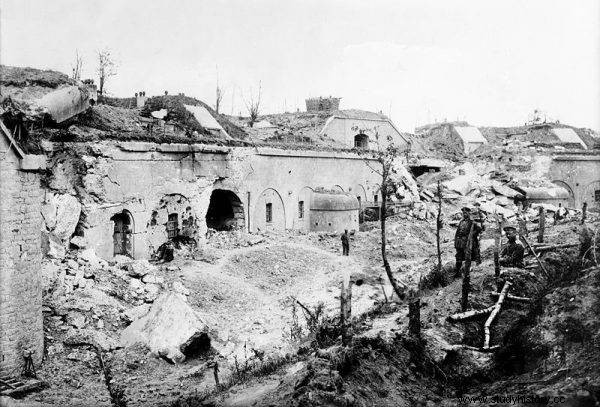The scale of wartime cruelty during the siege of the Przemyśl fortress was beyond the imagination of the people of that time. Terrified, they looked for consolation in… letters from heaven.
“It was terrible to see; in the place where the Muscovites tried to invade, there were at least 500 corpses in the narrow space, one on top of another . They lay so densely in front of one obstacle that literally could not see the ground "- recalled in October 1914 one of the imperial and royal defenders of the Przemyśl Fortress. Indeed, the scale of the cruelty of the war was beyond the imagination of the people of that time. Terrified, therefore, they looked for consolation in… letters from heaven.
Colossus…
The extremely favorable location of Przemyśl at the junction of trade routes running from Ukraine to Silesia and Hungary made an important strategic point on the map of Europe . In its turbulent history, "the city was subordinated to successive rulers, sometimes quite exotic" - writes in the book Fortress. The Siege of Przemyśl and the Roots of Europe's Bloodied Lands historian Alexander Watson. And he lists:
Until until 1340 Przemyśl was within the borders of Kievan Rus and the Ruthenian duchies that emerged as a result of it. Then it fell briefly into the hands of Ludwik Andegaweński, King of Hungary and Poland [earlier, the power over Przemyśl was taken over by Casimir the Great - ed. aut.] , and in 1387 was longer annexed to the Kingdom of Poland.

Archduke Fryderyk in the Przemyśl Fortress
However, this was not the end, because from the 15th to the 17th century the city on the San had to face the incessant invasions of Tatars, Transylvania, Wallachians, Hungarians, Zaporozhian Cossacks and Swedes. The strategic values of Przemyśl and the surrounding area were also noticed by the Habsburgs, under whose rule the city fell after the first partition of Poland. And preliminary plans for the construction of fortifications, which would play an important role in the event of the war between Austria and Russia, were drawn up as early as 1818. The Crimean War brought an additional impulse for expansion. Ultimately, however, the decision to transform Przemyśl into a first-class fortress was made only in 1871.
Although at that time the imperial-royal administration was more concerned with Italian affairs and problems with Denmark and Prussia, the established State Fortification Commission deemed it advisable to pay more attention to the eastern flank of the monarchy. And the construction of Przemyśl fortifications, which began a few years later, resulted in the creation of a huge fortress - the largest in Austria-Hungary and one of the three most powerful in Europe, after Verdun and Antwerp.
… on clay legs
Unfortunately, on the eve of the Great War, 48 km of fortifications with over 40 forts and an intricate network of roads and telephone lines were largely obsolete . Huge costs incurred, estimated today at nearly $ 210 million did not change the fact that the construction work was carried out for over 30 years. And during this time, the art of fortification underwent great changes. Indeed, as Alexander Watson writes:“The architects and engineers building the fortress tried to somehow keep pace with the changes. […] However, technology was changing so fast that it was impossible to keep pace with it. ”
The attitude of the general staff of the Austro-Hungarian army, which for a long time saw little sense in maintaining such a large complex, did not help either, putting hope in maneuvering operations. The Przemyśl fortress was to be a supply depot for the field army .

The text was created, among others based on Alexander Watson's book The Fortress. The Siege of Przemyśl ”, which has just been released by the Rebis publishing house.
The outbreak of the war in July 1914, however, changed the optics of the Imperial-Royal. military who began to attach much greater importance to the military rank of Przemyśl . Moreover, the general staff even moved their headquarters there from Vienna. From then on, Przemyśl's main task was to stop the greatest enemy forces. This was to enable the troops of the Central Powers to regroup necessary and then to launch an offensive against the Russian army. Thus, the fortress became an independent operating unit with nearly 130,000 sq m. soldiers from over 1 thousand department.
A choke in the throat
The first tsarist units appeared near Przemyśl on September 16. And just 10 days later, they completely closed the ring of encirclement, cutting it off from the world. Confident the commander of the Russian forces, General Radko Dimitriew hoped for a brilliant victory . Nevertheless, before he ordered the general assault, he sent to the commandant of the fortress, General Hermann Kusmanek a surrender proposal. The latter, however, faithful to the imperial will ordering the defense of Przemyśl at all costs, considered the Russian proposal to be offensive to the dignity of the Imperial-Royal. soldier.
It also quickly turned out that neither the tight blockade and the hurricane shelling, nor the subsequent surrender proposals brought the expected results. As a result, after an almost month-long siege, the Russians had to give way . Moreover, as Alexander Watson writes:
The siege of Przemyśl in 1914–1915 changed the entire course of the First World War. In the fall of 1914, when the Austro-Hungarian-German coalition suffered heavy defeats in the east and west, the Galician fortress and its 130,000 people played a key role in stopping the Russian invasion of Central Europe.

The commander of the Russian forces, General Radko Dimitriev, hoped for a brilliant victory.
The author of The Fortress is of no less importance he also attributes the Russian second siege of November , which was the longest during the Great War . And this despite the fact that ended with the surrender of Przemyśl after 133 days a. It was then that the bone in the throat of the tsarist command became a symbol of the courage and perseverance of Franz Joseph's soldiers. Especially since they have to face a completely new threat.
Bombs and…
“On the morning of December 1, 1914, a Russian plane appeared high above Przemyśl. The defenders opened fire, making a lot of noise, and pink and white clouds were blooming in the sky, which then began to blow away. In the snow-covered streets crowds of people gathered to watch everything with interest. Some watched intently. Others joked and laughed at how scared the pilot must be "- we read in Fortress Alexander Watson.
Horror quickly gripped the unaware onlookers, however, when the ground was struck by bombs dropped by the tsarist airplane . Panic broke out. People did not know how to behave - some were hiding in their houses, while others, fearing their collapse, ran out into the streets. And probably only in terms of a miracle should be seen the slight losses of one of the first bombing raids in the history, the aim of which was, inter alia, city and civilian population . According to the official version, the victim was a horse, the roof of one house and a few broken windows.
Soon terror from heaven became almost the norm. As the author of Fortress notes :"During the entire siege, Russian planes were to drop a total of 275 bombs on Przemyśl and its vicinity." And although they entailed little loss and destruction, “it seemed that the Russians had reached a new level of barbarism. The air strikes meant that no one could feel safe anymore, ”emphasizes Alexander Watson.
… letters from heaven
Despite the siege, life in the fortress seemed to go on in a fairly normal manner. There were entertainment venues, cinemas and newspapers. News from the world and fronts was also provided by the radio station, at least until it was destroyed by a Russian missile in March 1915. All this was very important for maintaining a good mental condition - especially of soldiers. This could not, however, replace more personal relationships. “The soldiers missed their families. When the second siege of Przemyśl began, the war had been raging for three months and even people whose homes were far from the front lines had plenty to care for the well-being and financial security of their loved ones. " And that could only be provided by postal correspondence.

Fort X "Orzechowce" in 1915
Unfortunately, after a short break between the first and second sieges, when efforts were made to catch up with the postal arrears, on November 7, 1914, postal deliveries by the Russians stopped again. In this situation, created a "second, completely new communication channel, namely the world's first airmail" - we read in Fortress . Although in fact pioneering steps in this area can be found during the Napoleonic Wars (balloon mail) and in India in 1911 (using an airplane), on January 4, 1915, the c.k. the command proudly announced the emergence of this revolutionary - at least according to him - initiative.
B ez replies
Whether revolutionary or not, the imperial-royal enterprise was enthusiastically welcomed. It even got to the point that in the absence of a sufficient number of aircraft, a balloon post was launched a few days later. "For this purpose, improvised, unmanned gas-filled balloons capable of carrying two kilograms of payload were used," writes Watson. Unfortunately, this solution had one major drawback. Sending correspondence was dependent on the whims of the wind, which did not always allow the balloon to reach the Austro-Hungarian territory.

Storming the Przemyśl Fortress
However, it was not only Zephyr's grace that had an impact on the effectiveness of the post office in Przemyśl. Its creators, in their innovative idea, did not foresee a way to deliver return mail on a regular basis. As a result, the letters reaching the fortress found their addressees only thanks to the kindness of the pilots . This further intensified the joy of the lucky ones who had the opportunity to receive news from behind the siege ring. One of them recalled the day after receiving a letter from his wife as follows:“The best day I spent here […]. Lovely photos, selected with so much love and understanding, long letters telling me that everything at home is quite tolerable.
Bibliography
- Bator J., The Galician War. Actions of the Austro-Hungarian army on the Northern (Galician) Front in 1914-1915 , Krakow 2008.
- Forstner F., Przemyśl Fortress , crowd. J. Bańbor, Warsaw 2000.
- Jabłońska H., Diary from besieged Przemyśl 1914-1915 , Przemyśl 2017.
- Kuca J ., In the besieged Przemyśl fortress (1914/1915) - in the light of memories and diaries , "Journal of the Institute of History of the University of Rzeszów" 4/2018.
- Watson A., Fortress. The Siege of Przemyśl and the Roots of Europe's Bloodied Lands , crowd. T. Fiedorek, Poznań 2019.
